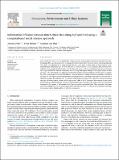Files in this item
Information diffusion between Dutch cities : revisiting Zipf and Pred using a computational social science approach
Item metadata
| dc.contributor.author | Peris, Antoine | |
| dc.contributor.author | Meijers, Evert | |
| dc.contributor.author | Van Ham, Maarten | |
| dc.date.accessioned | 2020-11-12T10:30:08Z | |
| dc.date.available | 2020-11-12T10:30:08Z | |
| dc.date.issued | 2021-01 | |
| dc.identifier | 271050296 | |
| dc.identifier | 30a878a5-ff95-45ef-bee1-b6d4d45f3808 | |
| dc.identifier | 85096234428 | |
| dc.identifier | 000596814400012 | |
| dc.identifier.citation | Peris , A , Meijers , E & Van Ham , M 2021 , ' Information diffusion between Dutch cities : revisiting Zipf and Pred using a computational social science approach ' , Computers, Environment and Urban Systems , vol. 85 , 101565 . https://doi.org/10.1016/j.compenvurbsys.2020.101565 | en |
| dc.identifier.issn | 0198-9715 | |
| dc.identifier.other | ORCID: /0000-0002-2106-0702/work/83481710 | |
| dc.identifier.uri | https://hdl.handle.net/10023/20956 | |
| dc.description | Funding: This work was funded through a VIDI grant (452-14-004) provided by the Netherlands Organisation for Scientic Research (NWO), and through the researcher-in-residence program of the Koninklijke Bibliotheek (KB), the national library of the Netherlands. | en |
| dc.description.abstract | News travels fast and far, and the general idea is that the spatial extent of news coverage has increased over time. Information flows are always involved in systems of interdependent cities. This is the reason why George Zipf and Allan Pred, both pioneers of the urban systems literature, were eager to obtain data on these relations to understand urban system dynamics. However, because of limited resources in data acquisition, they restricted their studies to small samples of cities or short periods of time. By using novel computational social science techniques on a digital archive of historical newspapers, we could map and explore changes in the spatial extent of news coverage in the Netherlands at an unprecedented detailed scale for a period of 62 years. In this paper, we analyse 24 million news items mentioning 312 different cities and towns in a sample of 31 local newspapers. Thanks to this data, we were able to reconstruct the information field of urban readerships from different cities and how it changed over time. By analysing their evolution, we find evidence of space-time contraction with an increasing coverage of faraway places in the period ranging from 1869 to 1930. However, this coverage is not evenly distributed but is characterized by a hierarchical selection process. Coverage of the largest cities in the Randstad increased at the expense of information flows from intermediate provincial cities. More generally, this paper shows how computational social science approaches may offer new ways of looking at urban dynamics with large text corpora such as digital archives of historical newspapers. | |
| dc.format.extent | 4384548 | |
| dc.language.iso | eng | |
| dc.relation.ispartof | Computers, Environment and Urban Systems | en |
| dc.subject | System of cities | en |
| dc.subject | Information flows | en |
| dc.subject | Gravity model | en |
| dc.subject | Netherlands | en |
| dc.subject | Historical newspapers | en |
| dc.subject | HE Transportation and Communications | en |
| dc.subject | HT Communities. Classes. Races | en |
| dc.subject | ZA4050 Electronic information resources | en |
| dc.subject | 3rd-DAS | en |
| dc.subject | SDG 11 - Sustainable Cities and Communities | en |
| dc.subject.lcc | HE | en |
| dc.subject.lcc | HT | en |
| dc.subject.lcc | ZA4050 | en |
| dc.title | Information diffusion between Dutch cities : revisiting Zipf and Pred using a computational social science approach | en |
| dc.type | Journal article | en |
| dc.contributor.institution | University of St Andrews. Population and Health Research | en |
| dc.contributor.institution | University of St Andrews. School of Geography & Sustainable Development | en |
| dc.identifier.doi | 10.1016/j.compenvurbsys.2020.101565 | |
| dc.description.status | Peer reviewed | en |
This item appears in the following Collection(s)
Items in the St Andrews Research Repository are protected by copyright, with all rights reserved, unless otherwise indicated.

